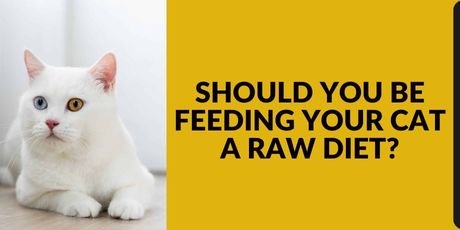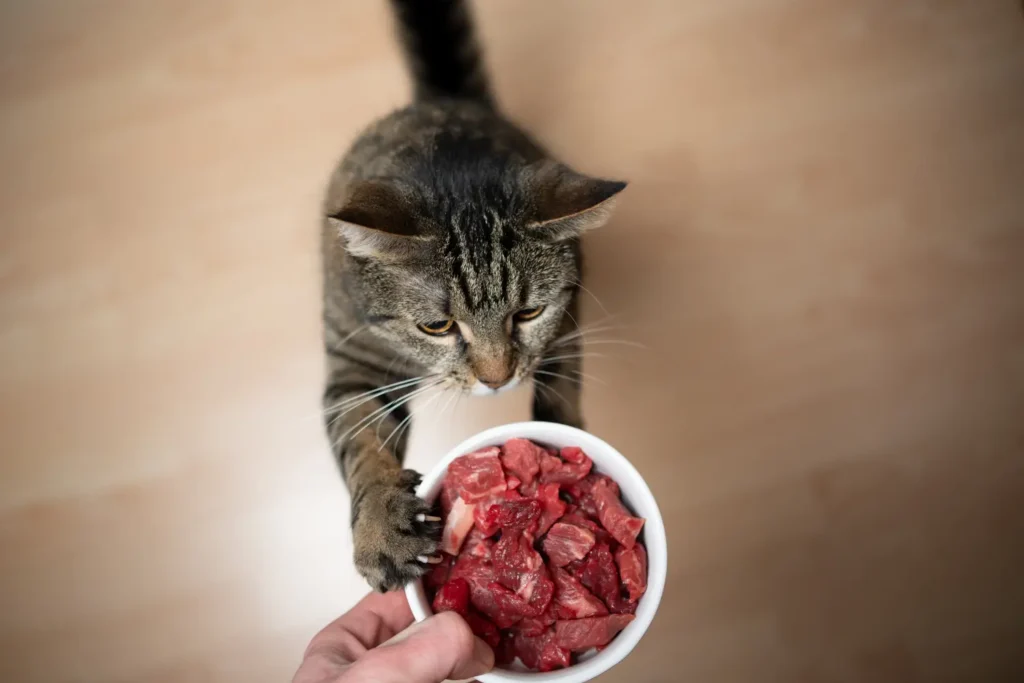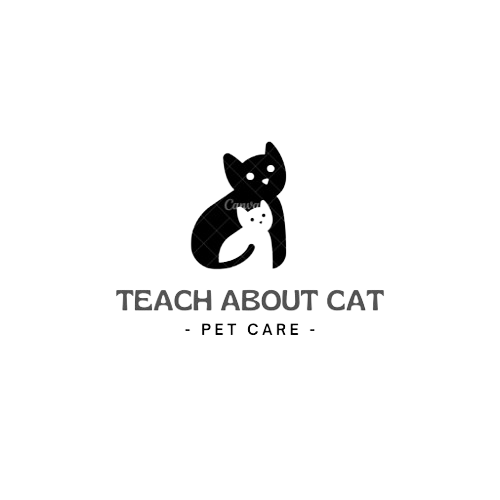In recent years, there’s been a tremendous growth in the popularity of raw food diets for cats and dogs. As an obligate carnivore, a cat might thrive on a raw diet that is safely prepared, complete, and balanced. However, embarking on this path of feeding your cat a raw diet is a significant responsibility, laden with intricate details. From personal experience, I’ve learned that while some owners advocate for its benefits, many experts advise against it, emphasizing the careful consideration and knowledge required for such a dietary shift.
Feeding Your Cat a Raw Diet
Feeding your cat a raw diet involves a balance of careful preparation, knowledge of nutrition, and an understanding of your cat’s specific needs. This approach, drawing from nature’s blueprint, can offer numerous health benefits but also requires awareness of potential risks and strict food safety measures. As pet owners navigate this path, consulting experts and considering individual feline health conditions are crucial for a successful dietary transition, ensuring the wellbeing and vitality of their beloved feline companions.

What is a Raw Diet?
In the realm of pet nutrition, the term raw diet is a broad term that often encompasses not only traditional raw food but also freeze-dried and dehydrated options. Generally, a raw diet for cats includes a variety of animal protein sources.
Typically, this comprises muscle meat, various organs, and bones, coupled with a fiber source. This diet is considered by many to be truly representative of a cat’s natural food, mainly because it’s not processed or altered by heat. From my experience in transitioning my cat to a raw diet, the variety and freshness of ingredients have been key factors to consider.
Also Read: Can Cats Eat Fish Food?
What are the Benefits of a Raw Food Diet for Cats?
For cats, a raw diet:
- Supports dental health
- Encourages water intake
- Provides more efficient protein due to lack of processing
- Includes lower carbohydrate levels to help prevent obesity/diabetes
Currently, many commercially available raw diets save time but require education and careful preparation at home.
Are Raw Food Diets Safe for Cats?
When considering whether raw diets are safe for cats, it’s crucial to acknowledge the risks. Well-known concerns include bacteria like Salmonella and E.coli. Cats, despite having shorter GI systems that reduce exposure to harm, are still susceptible to these dangers. As a cat owner, I’ve learned that the risk of cross-contamination can be alarming, and such pathogens can negatively affect both cats and their human companions.
Food safety is paramount. Ensuring thorough cleaning procedures are adhered to is vital. High Pressure Processing (HPP) is a safety step used in commercially available diets to eliminate pathogens without heat, helping to ensure both safety and nutrition. Cat parents should follow strict feeding guidelines and storage recommendations provided by the supplier.
What Health Concerns are Helped By a Raw Diet?
Evolved as desert dwellers, cats often lack a strong thirst drive. Raw diets, rich in moisture, can enhance hydration and alleviate urinary problems, thereby improving overall health. A common health concern in cats is kidney disease.
Healthy kidneys are crucial for metabolizing protein and processing waste. Heat processing in conventional cat foods can damage the foods’ amino acid profile, leading to lower protein efficiency and usability for the cat. A diet free from heat damage can potentially improve kidney health.
Who Should Not Use Raw Diets?
When delving into the realm of raw diets for cats, it’s crucial for pet owners to understand the associated risks and responsibilities. The Centers for Disease Control and Prevention (CDC) advises against raw feeding, primarily due to the challenges in preparing and storing these meals safely.
Not every pet owner might be equipped to ensure that the homemade, raw meals are complete, balanced, and safe, both for their pets and the humans in the household.
The risks of cross-contamination and improper handling are significant, posing health hazards to both animals and their human companions. Thus, those lacking the time or resources to commit to this meticulous process should carefully reconsider opting for a raw diet for their feline friends.

Are Raw Food Diets Complete & Balanced?
As a pet parent who’s deeply familiar with animal nutrition, I’ve learned that deciphering product labels is crucial. The term “complete and balanced” is not just marketing jargon; it signifies that a product meets the required nutrient inclusion for an animal’s specific life stage.
This is determined by the Association of American Feed Control Officials (AAFCO), a voluntary association that regulates the safety of animal feed in the marketplace. In my journey, working alongside animal nutritionists to create diets, I’ve seen how a “vitamin pack” or nutritional supplement is often used to ensure the nutritional profile is achieved in commercial foods.
However, when it comes to raw diets, the complexity increases. Without these carefully measured supplements, ensuring a balanced diet can be challenging. Hence, it’s imperative for pet owners venturing into raw feeding to understand these guidelines and consider the nutritional needs of their furry companions.
Also Read: What Should You Feed a Kitten?
How Can I Prepare a Raw Food Diet?
Embarking on raw feeding requires more than just throwing a piece of raw meat or fish into your cat’s bowl. While it seems simple, there is a serious danger in not providing a complete and balanced, homemade diet. These risks extend beyond the cat and can affect the human residents of the house. Food safety, storage, and cleaning practices are paramount.
It’s essential to consult with an animal nutrition professional to develop a diet that includes the right balance of protein, amino acids, vitamins, minerals, and ensures proper water intake. As someone who has navigated the complexities of raw diets, I can attest to the importance of these considerations for the health of both your pet and your family.
How Do I Transition My Cat to a Raw Diet?
Feline companions are notoriously finicky when it comes to their diets, making the shift to a raw diet a delicate process. Providing the least processed nutrition is often cited as the best thing for their health. Transitioning to raw food should be done progressively, introducing new foods over time. This approach is your best bet and can be accomplished by slowly phasing in raw food until it comprises the completely new diet.
Organizations like The Feline Nutrition Foundation, a non-profit dedicated to educating cat parents, can be invaluable resources. They offer informative guides on transitioning cats to raw diets, which can greatly assist in this process. Drawing from my own experience in transitioning pets to raw diets, patience and gradual introduction are key. It’s a journey that requires understanding your cat’s unique preferences and health needs.
Why Not Just Use Dry & Canned Diets?
The aforementioned benefits of feeding a cat a raw diet are often not realized with a processed diet. However, there are barriers to achieving a safe, complete, and balanced diet that may keep some cat parents from making the switch to preparing their own meals for their pets. A balance must be struck between convenience and healthy nutrition. While providing a healthy diet is the ultimate goal, the ease and practicality of dry and canned foods often hold sway in a busy pet owner’s life.
What are Raw Diet Alternatives?
Finding the perfect substitute for feeding a truly raw diet might seem challenging, but the goal of providing the best nutrition possible can be approached in various ways. Sometimes what is thought to be synonymous with a raw diet are options like freeze-dried or dehydrated diets.
These aim to avoid heat-processed ingredients and achieve minimal heat-damaged nutrition. Brands like RAWZ have worked with a team of animal nutritionists to develop raw-inspired, minimally processed nutrition options for cats, offering a practical alternative for pet owners seeking the benefits of raw feeding without the complexities of preparing a traditional raw diet.
What Do the Experts Say?
Speaking with KitchenImplement, Jodie Gruenstern, DVM, believes that a raw food diet is particularly important for cats (and dogs), given their status as stricter carnivores. In the same article, Erika Halle, DVM, discussed how such diets can help with weight management. Obesity is less likely with a raw food diet compared to processed, high-carbohydrate foods, which are often implicated in diabetes and obesity, now prevalent in cats today. This perspective underscores the need for a diet that aligns with the natural dietary requirements of felines, emphasizing the potential benefits of raw feeding in maintaining optimal health and weight in cats.
Is Raw Cat Food Good for Cats?
Feeding raw foods to cats remains a controversial topic. While their wild ancestors and even some domestic cats historically ate raw diets, this doesn’t necessarily mean it’s the best choice for all cats. Understanding the pros and cons of raw cat food diets is essential for making an informed decision about choosing the right healthy food for your cat. Each cat is unique, and what works for one may not be ideal for another, underscoring the importance of personalized nutrition.

Commercial Raw Cat Food vs. Homemade Raw Food for Cats
Raw cat foods come in different forms, offering pet parents the choice to either prepare them at home or opt for commercially available raw cat food diets. These are typically sold as either raw frozen or raw freeze-dried formulas.
There are also options like premixes that include vegetables, vitamins, and minerals, to which you can add raw meat. This provides a balance between ready-made pet diets and the option to purchase ingredients from local butchers. Each method has its own merits, but the best choice depends on individual preferences and the specific needs of your cat.
Homemade Raw Cat Food
Making your cat’s food at home gives you control over what they eat and might seem easy, but it’s important to remember that meat alone is not enough. Cats need the correct balance of amino acids, fats, vitamins, and minerals to thrive.
These nutrients are best provided in a combination of internal organs, along with appropriate vitamin and mineral supplements. Getting the ingredients in the right amounts and proportions is crucial for their health and well-being. To make matters worse, numerous studies have shown that it’s virtually impossible to find a nutritionally complete and balanced recipe for homemade pet foods in online or print sources.
It’s a good start to use a recipe designed by a veterinary nutritionist that meets your cat’s particular needs, but even then, it can be hard to stick to the paper-published guidelines. A 2014 study revealed that owners who made their pets’ meals at home eventually strayed from the recipes, which could lead to nutritional deficiencies or excesses over time.
Commercial Raw Cat Food
Commercially prepared raw cat foods take the guesswork out of feeding raw. Reputable manufacturers typically follow the guidelines set by the Association of American Feed Control Officials (AAFCO). When selecting a product, it’s crucial to make sure you find an AAFCO statement of nutritional adequacy on the label of the cat food you purchase. This ensures that the food meets industry standards for the nutritional needs of your cat, providing a balanced diet in a convenient, ready-to-feed form.
- Brand X Cat Food is formulated to meet the nutritional levels established by the AAFCO Cat Food Nutrient Profiles for adult maintenance, growth, and reproduction life stages.
- Animal feeding tests using AAFCO procedures substantiate that Brand X Cat Food provides complete and balanced nutrition for adult maintenance, growth, and reproduction life stages.
Confidently choose raw cat food that conforms to AAFCO standards to provide at least the basics of good feline nutrition.
Also Read: Can Cats Eat Cucumbers?
Are Raw Cat Food Diets the Same as the BARF Diet for Cats?
The acronym BARF is used to describe a specific version of homemade or commercially available raw cat foods. It stands for “Biologically Appropriate Raw Foods” or “Bones and Raw Foods.” Proponents of BARF highlight the inclusion of raw bone and internal organs in addition to foods, adding raw meat as key ingredients to create a balanced diet. While there are pros and cons to both BARF and non-BARF diets, understanding these nuances is essential for choosing the right raw diet for your cat.
Is Raw Cat Food Better than Other Cat Food?
Nutritionally, some cat foods that are widely available, including processed, canned, and dry varieties, can be inadequate. Raw cat food diets, with benefits ascribed to feeding cats a raw diet, have gained popularity. When switching to higher-quality, biologically appropriate foods, it’s important to consider the factors that make these different diets stack up against each other in terms of nutritional value and suitability for your cat’s specific needs.
High-Quality Ingredients and Digestibility
Both raw and cooked food ingredients have varying quality, but they are not always synonymous with high quality and high digestibility. While cooking improves the nutritional value of some foods, certain types of raw seafood contain thiaminase, an enzyme that breaks down thiamine. A diet consisting mainly of raw seafood puts cats at risk of thiamine deficiency, leading to poor appetite, seizures, or even death. Cooking breaks down thiaminase, making varieties of seafood safe for cats.
Nutritional Value
Scientific studies have shown that raw cat food diets can provide better nutrition than other types of cat food. A high-quality raw diet is often nutritionally superior to low-quality, processed food. However, it’s possible to achieve similar benefits by switching to a high-quality canned cat food, for example.
Safety Considerations for Raw Cat Food Diets
While raw cat foods can offer excellent nutrition, they come with drawbacks. Studies reveal that commercially prepared raw pet foods often have increased levels of contamination with potential pathogens like Salmonella, Listeria, and E. Coli, in comparison to regular pet foods.
The situation is not much better with foods prepared at home. The USDA estimates that approximately one-quarter of raw chicken parts in human food-production facilities are contaminated with Campylobacter bacteria and Toxoplasma gondii parasites, which can spread through raw cat foods.
It’s often heard that healthy adult cats have an innate resistance to foodborne pathogens, but cases and reports of cats developing or dying from diseases contracted through raw cat food exist. People living with cats that eat raw foods are also exposed to risks by handling contaminated foods or coming into contact with the cat’s feces. The risks posed are greatest to people and cats who are young, old, or immunocompromised.
Conclusion
Feeding your cat a raw diet is a journey that requires careful consideration and a deep understanding of feline nutrition. While the potential benefits of raw diets, such as improved dental health, hydration, and nutritional value, are compelling, they come with significant responsibilities regarding food safety and balanced nutrition. The decision to switch to a raw diet should be informed by scientific evidence, veterinary advice, and an awareness of the risks involved. Whether you choose commercially prepared raw foods, opt for homemade meals, or decide on an alternative, the ultimate goal remains the same: to provide the best possible nutrition for the wellbeing and longevity of your feline companion. Remember, each cat is unique, and what works for one may not suit another, making personalized nutrition the key to a healthy, happy cat.
Frequently Asked Questions about Feeding Cats a Raw Diet
Can I Feed My Cat Raw Meat Everyday?
Yes, cats can eat raw beef everyday, but it’s recommended to do so in moderation. Be aware of the risk of food poisoning. Ensure the meat is fresh and doesn’t contain seasoning or other substances hazardous to health.
Also Read: What Human Foods Can Cats Eat?
How Much Should I Feed My Cat on a Raw Diet?
A general rule of thumb is to feed approximately 2% of the body weight, divided into two meals a day. For example, a healthy 10-pound cat should have about 3 oz of raw food at each meal.
What is the Healthiest Raw Meat for Cats?
Chicken is a lean meat that is low in fat and sodium and easy to digest. While cats can eat Bacon, it’s not recommended in larger quantities as it’s typically high in salt and fat, which can cause health complications. Beef, Pork, Mince, and Lamb are also options.
Can Cats Eat Raw Eggs?
You should never feed your cat raw eggs. Like humans, cats can get foodborne illness, such as salmonella or E. Coli, from consuming raw eggs. According to reports from Hill’s Pet, Symptoms of these illnesses can include vomiting, diarrhea, and lethargy.







